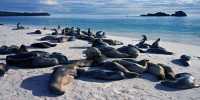In a new study, researchers at the University of Mānoa Hawaii argue that this observation is the largest aggregate of fish recorded in the deep sea. Their video footage shows a swarm of 115 cutthroat eels, more than double the previous record for the largest deep-sea fish.
In the pitch-black depths of the ocean, a truly unexpected scene unfolded: more than 100 eels.
Given the extremely scarce supply of food found at this depth, it is unusual to see such a large number of the same species in a single “animal”, so this new observation seems to change much of what marine biologists know about the mysterious abyss.
Reporting the discovery in the journal Deep-Sea Research Part I: This week’s Ocean Research Paper, the plane found this unexpected sight in the depths of the Pacific Ocean between Hawaii and Mexico) Attracts marine life in depth. The eels were attracted by a small bait package containing about 1 kilogram (2 pounds) of mackerel, which they ate before fleeing to the scene.
Interestingly, the eels were identified as Ilyophis arx, a species known as the cutthroat eels, a species that scientists rarely know because of their final choice of habitat. In fact, it is estimated that less than 10 specimens of this species have been collected worldwide.
Despite living deep in the ocean in the middle of the Pacific Ocean, these animals are not free from the pressures of human activity. The area they found is known by the deep-sea mining industry for minerals and metals such as copper, cobalt, zinc, and manganese, known as the Clarion-Clipperton Zone (CCZ).
Since little is known about the biodiversity of the region, it is not clear what impact it may have on beach inhabitants, but marine biologists are understandably concerned. As highlighted in previous studies, excavation can be a major hindrance to marine bed ecosystems and its damage is thought to be slow to heal.
“The impact on the deep-sea ecology could be far-reaching if this phenomenon is not isolated to just two beaches in the CCZ,” Leitner said.
















